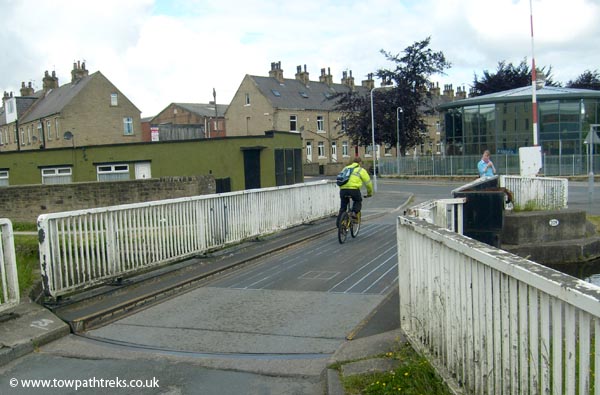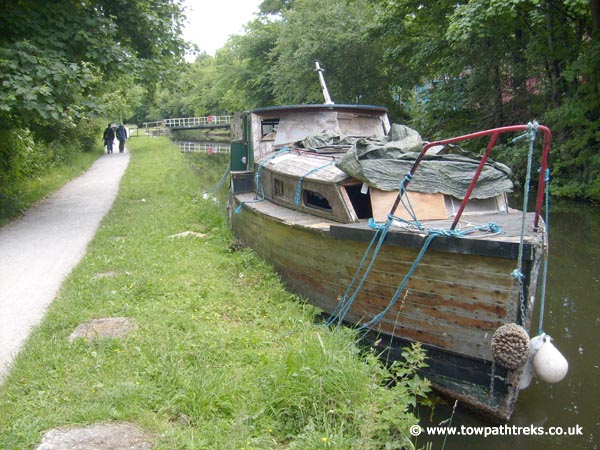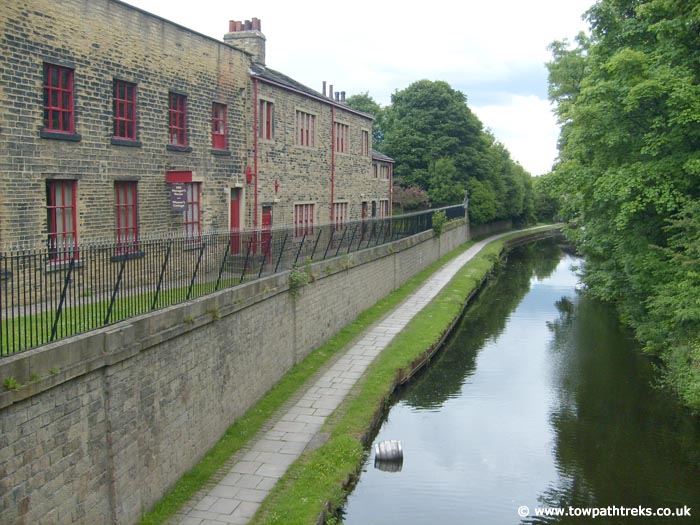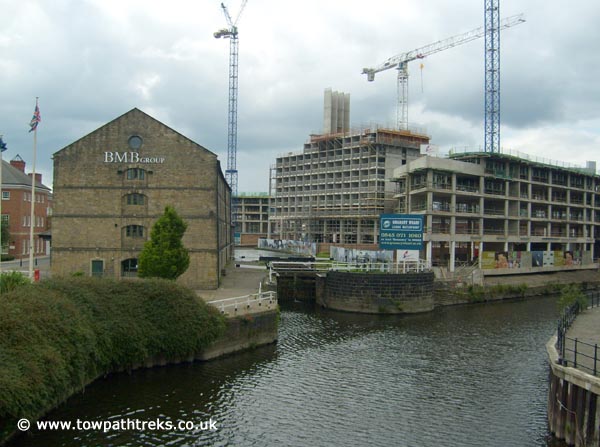After a quick breakfast at the hotel we headed off to the station. There was some confusion about which one of the two trains on platform was the one we wanted but at 8:40 we got on the Morecambe train and set off to Shipley. The trains route follows the canals and from the train I managed to spot a half milepost on the towpath. The railway cheats and goes through a tunnel where the canal follows the contour. The trip took about 15 minutes and Shipley was the first stop after the tunnel.
Shipley Station is triangular with three platforms and large free car park in the centre. Not far from the station we got onto the towpath at bridge #207C. We had already walked on the towpath at Shipley but not very far.
I paused at Dock Swing bridge #209, after the former junction with the Bradford Canal. I have some old photos of the canal in Shipley taken in the 1960s. One of the photographs shows Dock Swing bridge, not much has changed but a new building has recently been added to the view.

With Shipley quickly left behind us the canal enters Buck Wood. The majority of the walk was tree lined and very quiet. The water was crystal clear and still. It looked more like a mill pond than a canal, there were water lilies and pond weed and even pond skaters on the surface. The canal by the towpath was very shallow, not suitable for mooring boats. The clear water meant we could spot fish as easily as spotting birds or plants. There were lots of small fry, some young perch, a baby pike and a huge carp, along with some other unidentified fishes.
Most of the bridges on this bit of canal are swingbridges. There are only a few of the typical stone L&L bridges. there are quite a few locks, evenly spaced out along the walk. They come in rises, either 2 or 3 rises, or indiviually. The use of rises (locks joined together, sharing gates) shows that this stretch is one of the old bits of canal. Elsewhere at Greenberfield the rises were replaced by individual locks to save water.
Other than brief brushes with civilisation at Rodley and Apperley Bridge the canal is flanked by trees and fields with some nice views. At Kirkstall you can see across the fields to the ruins of Kirkstall Abbey.
There are plenty of mileposts on this stretch, a sign at the end of the walk explained that the posts in the last 10 miles of the canal were replaced or refurbished in the 1990s. Even so we couldn't find milepost 117 despite it being on the 2005 OS map.
The towpath is very popular with cyclists. It is one of the national cycle routes. While it is good to see so many people enjoying the canal we did seem to spend a lot of time looking over our shoulders or stepping out of the way of speeding bikes. The cyclists outnumbered the walkers by 10:1. There were some people fishing and a group in inflatable kayaks. We only saw 4 canal boats on the move all day and they were just narrowboats.

Two miles from the end of the walk at Armley we stopped off to visit Armley Mill and its industrial museum. It was £3.00 to get in and we were shown the mill house which is set up to show how the rich mill owner and a poor mill worker would have lived. The museum has looms and spinning machines, engines, a display about cinema and cameras. It was interesting but the whole museum is a bit run down now and obviously hasn't had any money spent on it in along time. There were only half a dozen people looking around it while we were there.

From Armley it is just one and three quarter miles to River Lock and the end of the Leeds & Liverpool Canal. The last bit of the canal passed by quite quickly. At Oddy Lock we heard sirens, a reminder that the city was close by. From here on the city started to make itself known. There are more buildings, some had past links with the canal. The railways grew closer, crossing the canal on high bridges or just the remains of former bridges from disused lines. The skyline looking towards the city would be unrecognisable to anyone from 10 years ago let alone 250 years ago. New buildings are growing up all the time though I suspect they wont last as long as the few remaining chimneys have done.
As the canal, railway and River Aire draw closer and the city engulfs them all there are still some interesting wildflowers growing on the towpath.
At River Lock there are new buildings being constructed on the side of the basin, on the former car parks. There is little fanfare to mark the end/beginning of the Leeds & Liverpool Canal. Just a faded welcome sign. With just 4 boats on the move on a sunny summer Sunday it seems that this end of the canal is just as quiet as the Liverpool end.
As we walked back to the hotel the clouds became darker and it started to rain.

Later on we went out for some food and a drink. Coming from Liverpool the Adelphi pub sounded the right sort of place for us. It is next to Leeds Bridge on the River Aire/Aire and Calder Navigation. It is a once grand Edwardian pub/gin palace similar to the Vines pub in Liverpool. The pub has etched windows and some fine tiles and woodwork. I had a strong cider, 7.5%, but the Butcombe Blonde was nicer. Unfortunately they had run out of Sunday roasts by the time we got there so we had to look elsewhere for food and ended up in a noodle bar. We walked up Kirkgate, past the Palace pub, said to have 12 real ales, and up to Crown Point bridge. Over the bridge we visited Clarence Dock which is surrounded by new buildings including the Royal Armouries. The area was quiet as we walked back to the hotel.
No comments:
Post a Comment